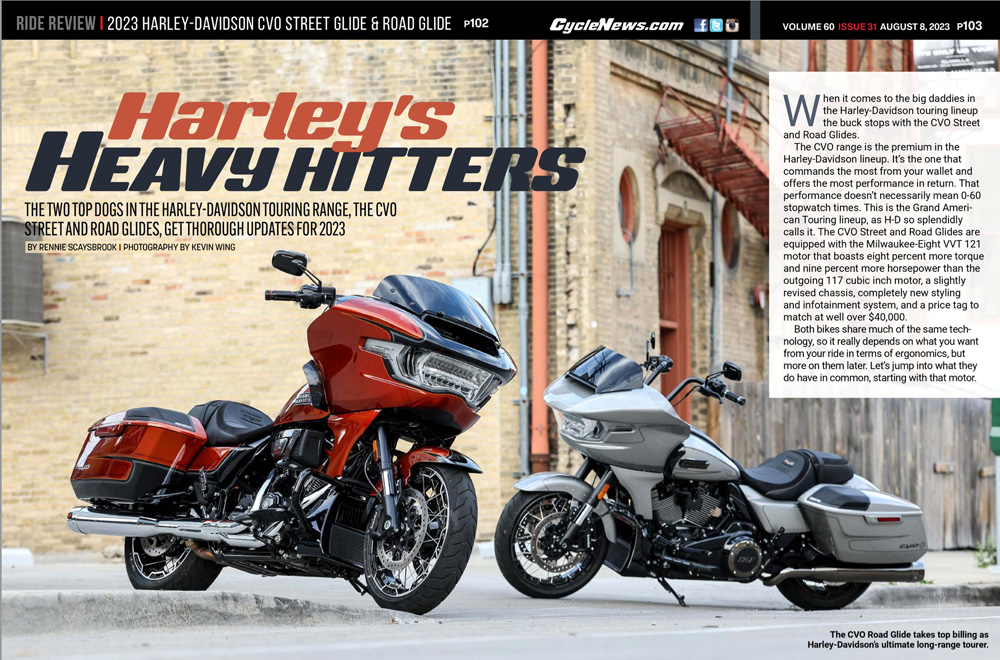Rennie Scaysbrook | August 10, 2023
The two top dogs in the Harley-Davidson Touring range, the CVO Street and Road Glides, get thorough updates for 2023.
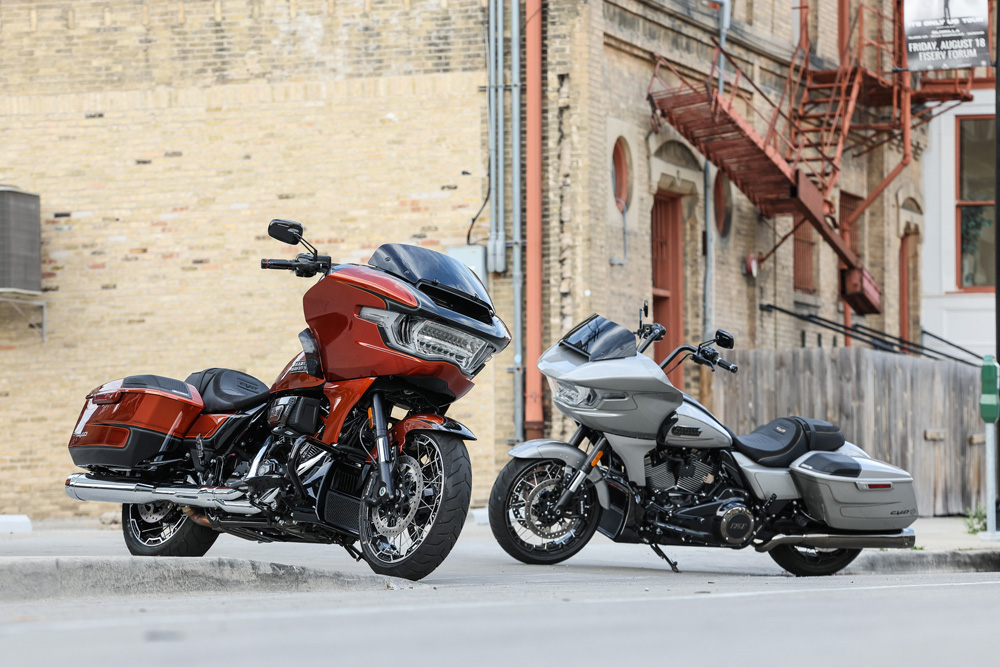 The CVO Road Glide takes top billing as Harley-Davidson’s ultimate long-range tourer.
The CVO Road Glide takes top billing as Harley-Davidson’s ultimate long-range tourer.
Photography by Kevin Wing
When it comes to the big daddies in the Harley-Davidson Touring lineup the buck stops with the CVO Street and Road Glides.
The CVO range is the premium in the Harley-Davidson lineup. It’s the one that commands the most from your wallet and offers the most performance in return. That performance doesn’t necessarily mean 0-60 stopwatch times. This is the Grand American Touring line-up, as H-D so splendidly calls it. The CVO Street and Road Glides are equipped with the Milwaukee-Eight VVT 121 motor that boasts eight percent more torque and nine percent more horsepower than the outgoing 117 cubic inch motor, a slightly revised chassis, completely new styling and infotainment system, and a price tag to match at well over $40,000.
Both bikes share much of the same technology, so it really depends on what you want from your ride in terms of ergonomics, but more on them later. Let’s jump into what they do have in common, starting with that motor.
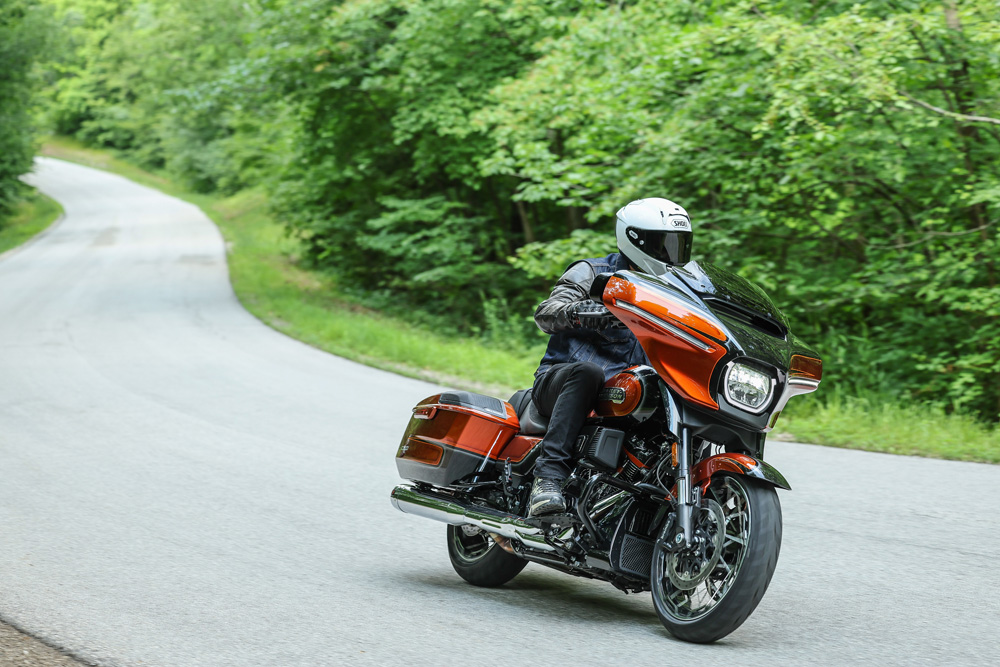 The CVO Street Glide has its fairing mounted to the fork, which means you’re steering it as well as the motorcycle itself.
The CVO Street Glide has its fairing mounted to the fork, which means you’re steering it as well as the motorcycle itself.
Road Glide CVO and Street Glide CVO Engine
Having high displacement V-twins out of Milwaukee is nothing new, but the little VVT badge at the bottom of the push rods is. Variable Valve Timing has been featured on Japanese and European bikes for years, but the technology has been conspicuously absent from American V-twins.
“When we set out to create this new evolution of the Milwaukee-Eight powertrain, we had three main focus points—weight, efficiency and performance,” says Christina Exner, Principal Engineer, Harley-Davidson Motor Company. “We’re 39 pound-feet up to 139 from the previous 117 c.i. motor. The horsepower now 115, which is up almost 10 percent from the 117.”
Operating on a single camshaft, the Variable Valve Timing system moves through 40°of crankshaft rotation, equaling 20° of cam rotation. There’s a phaser located between the cam drive sprocket and the camshaft that uses a solenoid plunger to control the hydraulics to change the cam timing, with the VVT system helping to improve the fuel economy a claimed three-to-five percent.
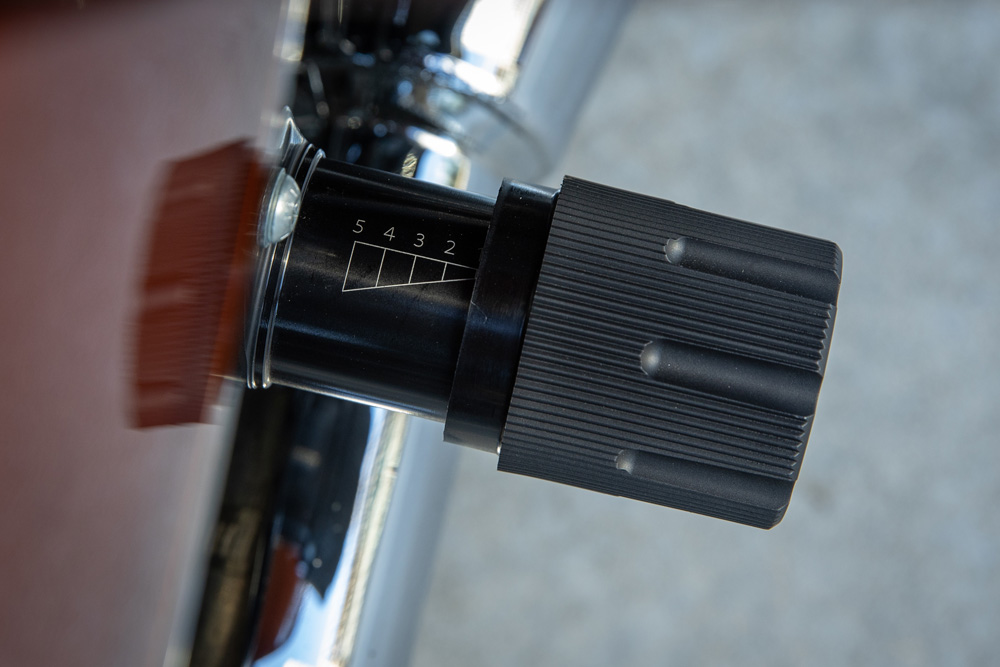 A preload knob on a $42,000-plus motorcycle instead of dedicated electronic suspension is disappointing.
A preload knob on a $42,000-plus motorcycle instead of dedicated electronic suspension is disappointing.
“We use a very unique phaser that takes advantage of the small number of cylinders were have,” continues Exner. “With the two cylinders, we have one event, so to speak, per revolution. We get a pretty torquey characteristic. We use the cam torque itself to actuate the phaser, so we don’t need the oil pressure from the oil pump. We use that and we have a valve that sits in the center of the phaser that allows us to pump oil between the two chambers of the phaser to advance or retard the phaser. It’s very clever system. The single biggest contributor to the performance increase is very likely the camshaft. We’re using a very aggressive cam to reach the performance numbers we’re achieving.”
Liquid-cooling focusing on the exhaust valve area for each cylinder head helps dissipate heat and keep the rider cool and, working with the larger four-liter airbox, 3mm larger, single throttle body (58mm), longer piston stroke and revised combustion chamber, sees compression go from 10.2:1 to 11.4:1.
The first thing that strikes you is how creamy smooth that new motor is. From just over idle the torque to 4000 rpm is like butter (there’s another 1300 rpm to go but it’s best to keep the motor revving around this number). It will burst up through that rev number surprisingly quickly for such a big motor, but the spread of performance is very impressive with a 0.5-inch larger 4.5-inch muffler system roaring the Harley roar.
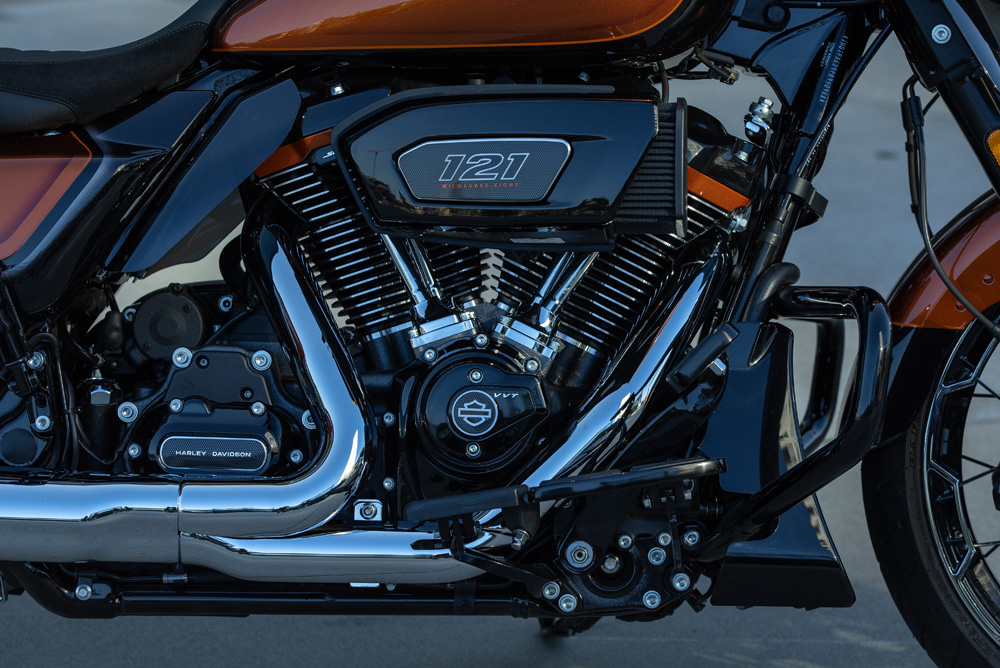 The VVT-equipped 121 cubic-inch motor is a thing of beauty.
The VVT-equipped 121 cubic-inch motor is a thing of beauty.
There’re five variable ride modes at your convenience including a Sport and two Custom modes, and I found the best throttle response was in the Road mode as Sport seemed a little too urgent for the style. The initial throttle response in Road is almost perfect, although you do get less midrange power than in Sport. You also get a higher level of Combined ABS and Combined Traction Control intervention.
All that torque is delivered through a six-speed gearbox, one that’s still devoid of a quickshifter, like the one touring rivals BMW long ago fitted to their K 1600 GTL. However, the shift itself is exceptionally smooth for such a massive V-twin and doesn’t need the clutch most of the time, just a slight roll of the throttle and it’ll snick into the higher gear nicely.
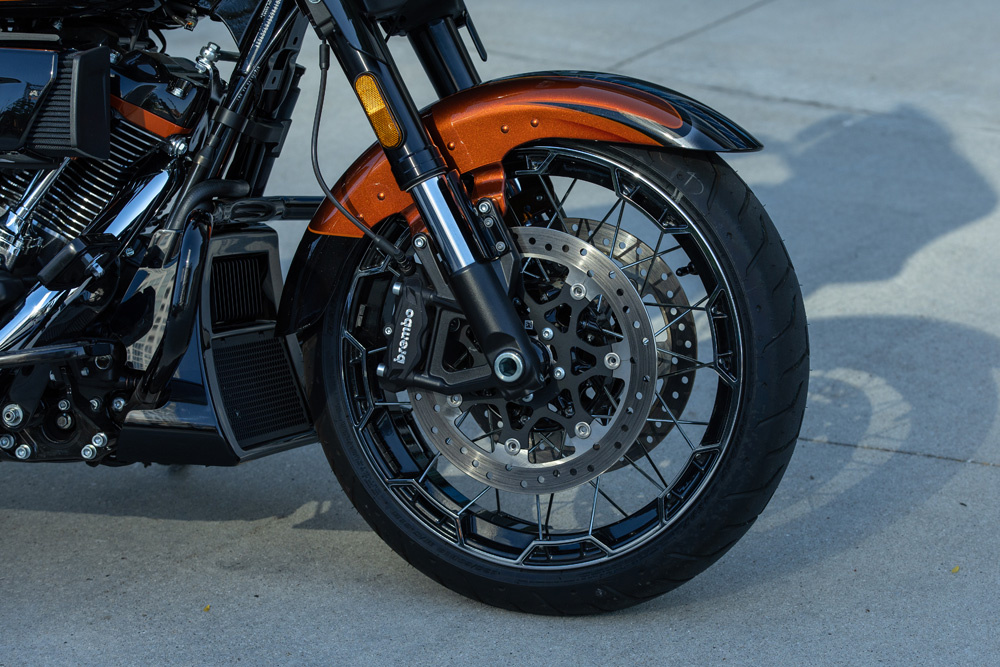 Brembo brakes are quality units but the non-adjustable forks leave a little to be desired.
Brembo brakes are quality units but the non-adjustable forks leave a little to be desired.
CVO Street Glide & CVO Road Glide Chassis
H-D hasn’t gone after wholesale changes to the chassis in the same way they have with the motor.
The main steel tube/backbone frame remains the same, but there are new 47mm forks with 4.3 inches of travel and four-piston Brembo monobloc brakes gripping larger 320mm discs (up 20mm).
At the rear is a Showa shock with preload and rebound damping, now sporting 50 percent more travel at—wait for it—three inches. Not much, I know.
Harley-Davidson really missed an opportunity with these CVOs to usher in electronic suspension adjustment. There’s no adjustment on the fork, and while the rear has preload and rebound, rebound changes need to be made with the bags removed, and preload changes are accomplished by a knob on the left side of the bike.
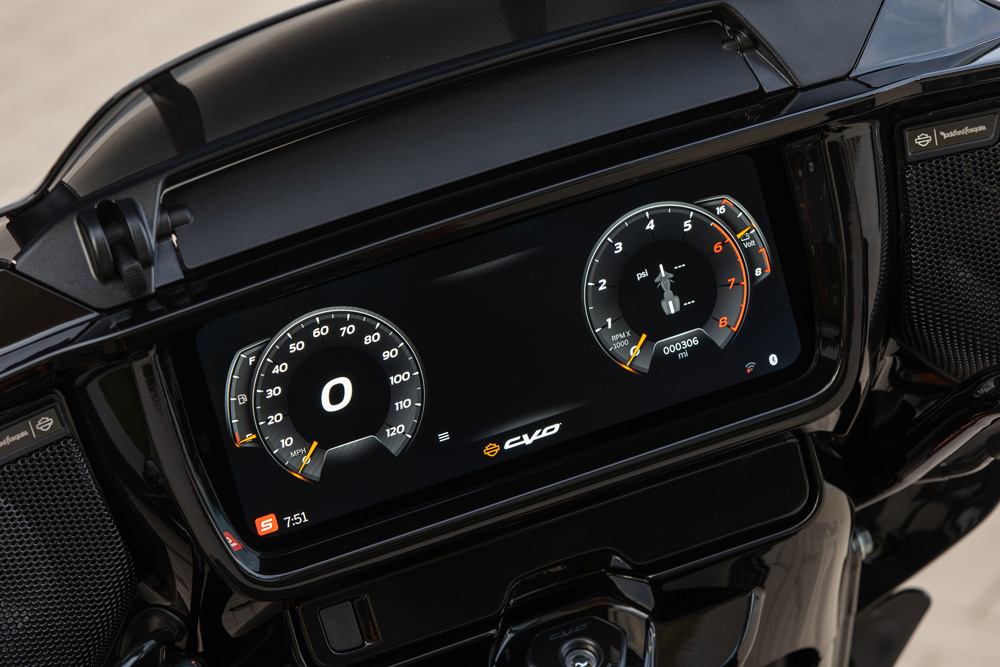 This is by far the best dashboard in the game today.
This is by far the best dashboard in the game today.
Considering the price and the fact these bikes are designed to be loaded up with multiple people and luggage, thus greatly affecting the way the bike rides, and cover massive distances with almost every kind of road surface imaginable, I think push-button electronic suspension adjustment should have been a given for these chart-topping CVOs. Knobs and spring collars are not revolutionary technology, and I can’t think of why electronic springers weren’t fitted when there are other machines in the Harley lineup that have them.
That being said, the ride quality is quite good, but I only rode both the Road and Street Glide CVOs on flat, smooth Wisconsin roads with no luggage, so the jury is still out on touring ride handling with a passenger.
The main difference between the Road and Street Glide is the fork-mounted fairing on the Street and the lower-set handlebars. The Road Glide’s fairing is attached to the frame, which gives it a lighter feeling at the handlebars. The wind buffeting is also less on the Road Glide thanks to the wider, taller screen and fairing that protects the rider’s shoulders more, and both bikes come with closeable side deflectors that direct hot air away from the rider. The higher handlebars on the Road Glide are nowhere near as uncomfortable as I thought they’d be, and I much preferred them over the cramped position I found with the Street Glide.
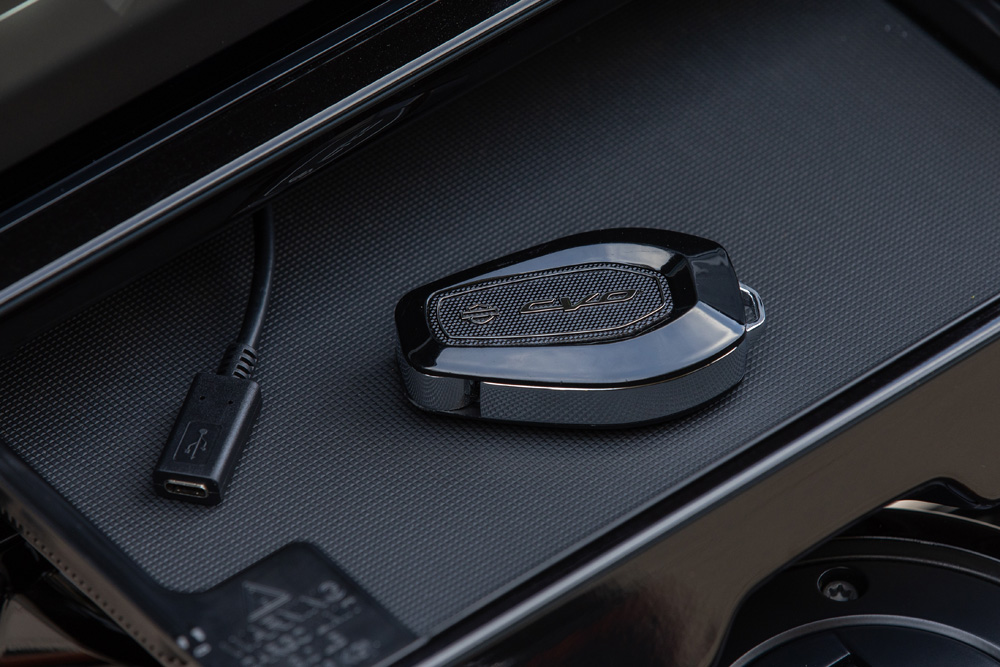 Glove compartment is vast for storing phones and wallets.
Glove compartment is vast for storing phones and wallets.
However, I found both bikes to have a slightly awkward position for the floorboards in that they were about three inches too far forward for my liking. This in turn put too much strain on my lower back, making for an uncomfortable ride after an hour on board.
The revised seat is fantastic for short trips but if I were buying either the Street or the Road Glide, I’d be investing in a custom seat, pronto.
Both bikes have a claimed 32° lean angle and weigh north of 800 pounds, so you need to be careful not to crunch the floorboard when you’re on your next big tour. That being said, you can hustle these bikes along well, but don’t go pretending you’re Kyle Wyman on his particular King of The Baggers Road Glide. You won’t get past the next corner.
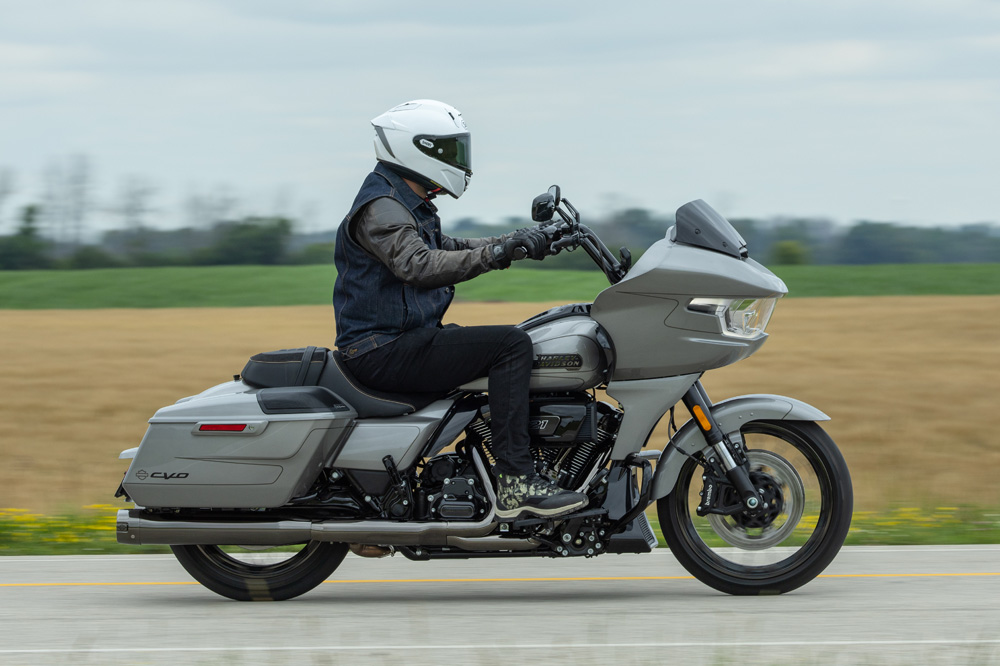 Mini ape-hangers on the Road Glide offer a more comfortable ride than the lower-set bars on the Street Glide.
Mini ape-hangers on the Road Glide offer a more comfortable ride than the lower-set bars on the Street Glide.
CVO Street Glide & CVO Road Glide | Infotainment & Electronics
Easily one of the stars of the new CVO show is the gigantic 12.8-inch touchscreen TFT dash. This is the biggest production dash on the market today, and its layout and ease of use is exceptional.
You’ve got menu buttons, cruise control, and the locator joystick on the left handlebar but once you get used to using the touchscreen with your gloves on, it’s a bit of a gamechanger. Harley-Davidson’s also put in a massive Rockford Fosgate Stage II audio system powered by a new four-channel, 500-watt RMS amplifier. The system includes the Stage II three-way 6.5-inch fairing speakers, and twin Stage II three-way 5×7-inch saddlebag speakers, but you’ll have to go to the accessory catalog if you want the Stage III 6×9-inch saddlebag speakers that we had on the test.
This is probably the most robust speaker system I’ve yet tried on a production motorcycle. It absolutely pumps and is so loud as to (almost) mitigate most wind noise distortion at 60 mph.
Harley’s designers have done extremely well with the graphic layout and ease of use with the system, and you’ve got Apple Car Play at your service to make it even easier. However, if you’ve got an Android phone, you’ll run into problems, as Android Auto no longer supports motorcycles, which means streaming music and taking phone calls are all you’ve got.
Cruise control is a given for a bike of this nature, but, like the lack of electronic suspension, Harley-Davidson missed a trick by not fitting radar-adaptive cruise control. This is an even bigger omission than the electronic suspension because these bikes are designed to cover massive miles, often on the freeway, and the fact there are bikes literally half the price of these CVOs on the market that come with radar-adaptive cruise control feels like H-D is falling behind the times when they should be leading them.
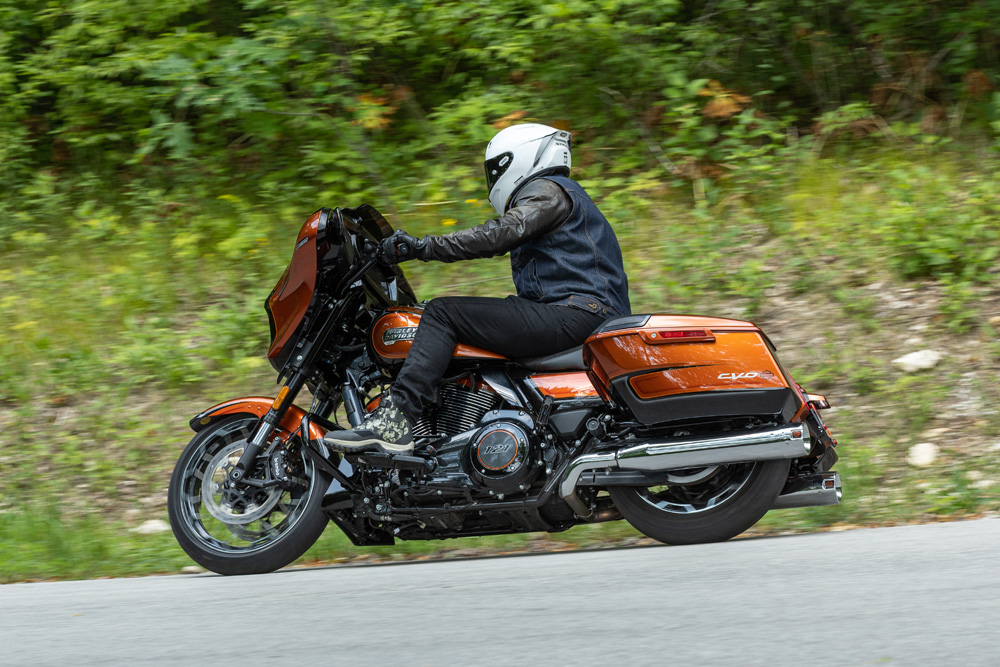 The Street Glide is slightly heavier steering than the Road Glide but it’s minimal.
The Street Glide is slightly heavier steering than the Road Glide but it’s minimal.
CVO Street Glide & CVO Road Glide | Wrap Up
The Road Glide CVO and Street Glide CVO both start at a whopping $42,999 and you can throw on an extra $6000 if you want the stunning Whiskey Neat with Raven Metallic paint scheme we had the Road Glide in, so you are paying absolutely top dollar for Harley’s top-line touring machines.
They are very regal motorcycles and perform exceptionally well on the open road. However, the fact there’s no electronic suspension adjustment for a bike that will vary its payload significantly or the lack of adaptive cruise control, make for a black mark against the models. At least Harley have given themselves room for improvement.
Still, the ride experience is very good. The VVT-equipped motor is by far the smoothest I’ve yet tried from Harley-Davidson and the infotainment suite is the best I’ve tried on the market from any manufacturer in any category.
They are stunning machines and if you can look past the electronics omissions, you’ll not find a more luxurious motorcycle on which to cross America. CN
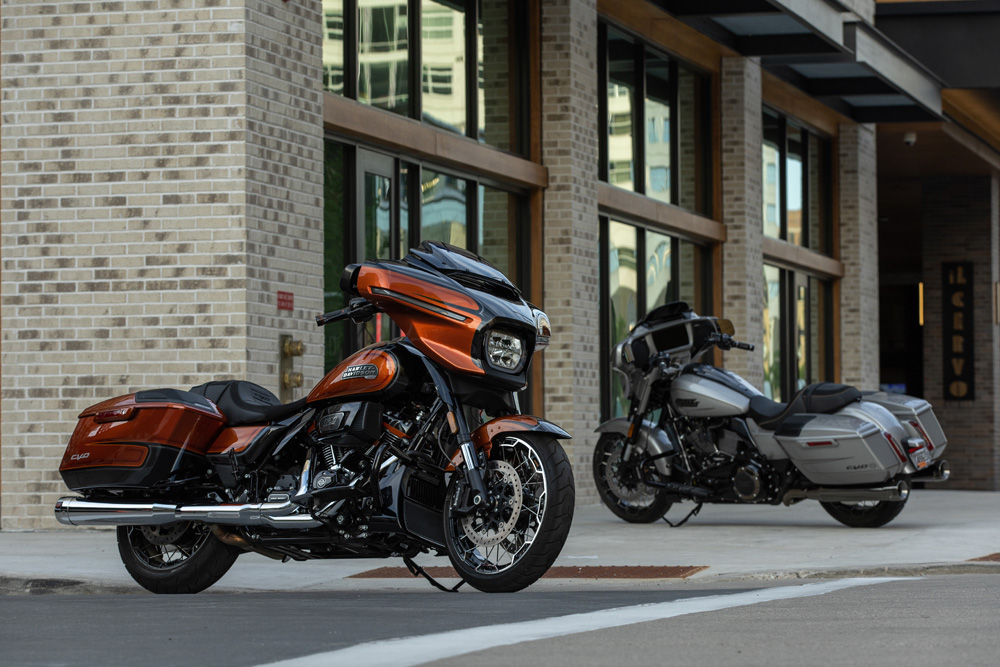
2023 Harley-Davidson CVO Road Glide & Street Glide Specifications
| MSRP |
$42,999 |
| Engine: |
45° V-twin, 4-valves per cylinder |
| Cooling System: |
Liquid-cooled |
| Displacement: |
1977cc |
| Bore x Stroke: |
103.5 x 117.5mm |
| Fuel Injection: |
EFI, 50mm elliptical throttle bodies, Ride-by-Wire throttle |
| Claimed Power: |
115 hp at 4500 rpm |
| Claimed Torque: |
139 lb-ft at 3000 rpm |
| Compression Ratio: |
11.4:1 |
| Exhaust: |
2-1-2 |
| Transmission: |
6-speed |
| Clutch: |
Wet multiplate |
| Electronics: |
Six Riding Modes, Power Modes, Cornering ABS, Traction Control, Cruise Control, Power Launch, full LED lighting, Daytime Running Light, backlit handlebar switches, 12.8″ TFT color display |
| Chassis: |
Steel tube backbone |
| Front Suspension: |
47mm fork, non-adjustable |
| Rear Suspension: |
Dual emulsion shocks, monoshock, rebound damping and preload-adjustable |
| Front Brake: |
Dual 320mm discs, radially mounted Brembo monobloc 4-piston calipers, Cornering ABS |
| Rear Brake: |
300mm disc, Brembo 2-piston caliper, Cornering ABS |
| Front Tire: |
Dunlop H-D Series bias blackwall, 130/60B-19 in. |
| Rear Tire: |
Dunlop H-D Series bias blackwall, 180/55B-18 in. |
| Rake: |
26° |
| Trail: |
6.7 in. |
| Wheelbase: |
64 in. |
| Seat Height: |
28 in. |
| Fuel Capacity: |
6.0 gal. |
| Weight (curb): |
838 lbs. / 862 lbs. (Road Glide) |
